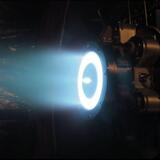[This article has been updated, original publish date: April 8, 2024]
Since the dawn of the Space Age, objects in space have traveled along predictable, gravity-driven paths first defined by the German Renaissance astronomer and mathematician Johannes Kepler.
For decades, those predictable orbits served our nation well, making space essentially a sanctuary. However, in today’s congested, contested and competitive space area of operations (AOR), relying solely on Keplerian orbits is no longer sufficient.
During public appearances, including at the 2023 Space Symposium in Colorado Springs, Colorado, then-Deputy Commander of U.S. Space Command Lt. Gen. John Shaw said maneuverability—regardless of the domain—enables military forces to move quickly, sidestep defenses, and achieve surprise. He asserted that space should be viewed no differently than any other operational domain.
"Dynamic Space Operations (DSO) fundamentally revolve around the capability to maneuver once in orbit," stated Adam Dissel, Director of Transformation for Space Propulsion & Power Systems at Aerojet Rocketdyne, L3Harris. "This maneuverability adds complexity to an adversary's planning and targeting efforts."
For example, because ground-surveillance satellites follow predictable orbital paths, adversaries typically know when one will be overhead and can modify their behavior accordingly. Similarly, space surveillance operations would benefit from the ability for satellites to maneuver in unique orbits to take a closer look at objects of interest. If conflict breaks out in the space AOR, maneuverable satellites can complicate an adversary’s ability to target and deny our space operations.
“All of this necessitates greater propulsion capability than what has traditionally been possible,” Dissel said.
L3Harris, a longtime global leader in rocket and in-space propulsion systems, offers several DSO-enabling capabilities, with more in development. These propulsion capabilities provide the speed and efficiency to maneuver without regret. Some examples include:
- Electric satellite thrusters with 10 times the efficiency of conventional chemical propulsion systems.
- A long-life version of the company’s high-thrust RL10 upper stage rocket engine, an industry workhorse capable of multiple in-space restarts that has sent probes across the solar system and beyond.
- High-performance propellants that are more efficient and environmentally friendly than hydrazine and other chemical fuels typically used for in-space propulsion.
- Air-breathing electric propulsion systems for satellites operating in very low Earth orbit (VLEO). Because they draw their propellant from the residual atmosphere in VLEO, these systems have virtually unconstrained maneuverability.
- Long-life monopropellant thrusters for refuelable space vehicles.
- High Delta-V Integrated ESPA (EELV Secondary Payload Adapter) Propulsion Systems to provide significant maneuverability capability to smaller space vehicles.
- Long-life, high-performance bipropellant liquid rocket engines for higher-impulse DSO maneuver requirements.
- On-orbit refueling and propellant management systems for monopropellants and cryogenic propellants.
“L3Harris offers highly reliable and long-life propulsion solutions for any mission,” Dissel said, highlighting that when it comes to DSO, there is no one-size-fits-all propulsion system.
Electric propulsion is one example. It is ideal for mass-constrained satellites that do not require high-speed or long-distance maneuverability. These systems enable planners to devote only a small amount of total available satellite mass to propellant.
L3Harris electric thrusters have long been operational aboard commercial and government satellites, and the company is developing higher power systems to support NASA’s exploration goals. Electric thrusters provide low-thrust, high-specific-impulse propulsion for missions needing more efficiency than speed.
Additionally, L3Harris is working on a longer-life RL10 upper stage engine that could relocate payloads days or even weeks after launch, making them difficult to track. In one scenario, a primary satellite might initially be launched to geostationary orbit (GEO), and the upper stage then maneuvers a secondary payload into a disposal orbit—an area of space above GEO that serves as a graveyard of sorts for spent hardware. The upper stage could then restart on demand and deliver the secondary payload to the orbit required to perform its mission.
“The long lifespan and restart capability of the RL10 complicates an adversary's strategy, as they must now monitor all disposal orbits for potential future actions,” added Dissel.
Restarting an engine that has been inactive for extended periods in the extreme cold of space is a “nontrivial” challenge, Dissel said, but the long flight history of the RL10 as a restartable upper stage engine provides a trusted solution to expand the restart timeline available to position on-orbit assets.
Another DSO capability of interest to the Space Force is on-orbit satellite refueling, which is another area where L3Harris products shine. L3Harris’ chemical and electric propulsion systems have an unrivaled track record that gives mission planners confidence in their durability and ability to safely conduct proximity operations.
“Refueling is pointless if your thrusters are going to burn out,” Dissel said. “You need a thruster that remains operational, and that's where we provide an advantage.”
That translates into an advantage for the Space Force as it deals with increasingly capable adversaries in a contested space environment. DSO is about upending the predictability that has traditionally defined orbital operations through propulsive maneuverability, something that plays to the strengths of L3Harris.

